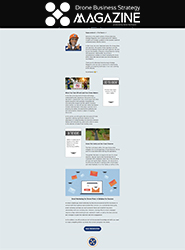
Is it possible to predict the future of your drone service business? I adamantly say, Yes! What if you could see around corners? Know what’s beyond visual line of sight? Imagine having the power to foresee potential challenges and opportunities, allowing you to navigate your path with confidence. As solo drone pilots, we face a world filled with uncertainties—changing regulations, market fluctuations, and evolving technology. But we don’t have to feel lost.
By creating a financial proforma, you take charge of your future. This tool empowers you to project your revenue, understand your expenses, and prepare for different scenarios that might come your way. It’s not just about numbers; it’s about gaining clarity and control over your business.
In this article, I guide you step-by-step in building your own proforma. Together, I cover the strategy you need to make informed decisions, seize opportunities, and confidently steer your drone business toward growth.
1. Why a Proforma Matters for Solo Drone Pilots
A proforma is a financial projection that enables you to predict your business’s future performance by considering various factors like revenue streams, operating costs, and potential market changes. For solo operators, the proforma offers crucial insights into:
- How much revenue you can realistically expect from different service offerings
- What your recurring and one-time expenses will look like
- How external factors such as regulations or increased competition could impact your bottom line
By understanding these variables, you can better prepare for growth, avoid financial pitfalls, and ensure the long-term success of your drone service business.
2. Components of a Proforma for a Solo Drone Business
When building your proforma, focus on the following key areas:
Revenue Forecasting: Break down your revenue projections by service category (e.g., aerial inspections, real estate photography, event videography). Estimate how many jobs you expect to book monthly and the average price per job. For example, if you’re targeting 10 real estate shoots at $300 each, your monthly revenue for that service would be $3,000.
Direct Costs (COGS): These are costs directly tied to your services, such as:
- Drone maintenance and repair
- Insurance premiums (critical for commercial operators)
- Drone software subscriptions for mapping, video editing, etc.
- Battery replacements and expendables
Operating Expenses: General business expenses include:
- Marketing and advertising (social media ads, website maintenance)
- Office expenses (software, internet, phone)
- Professional services (legal, accounting, or financial consulting)
- Travel costs (mileage, hotel stays for out-of-town shoots)
Capital Expenditures: If you plan to invest in new drones, cameras, or other major equipment, account for these as capital costs.
Profit Margin: After calculating revenue and expenses, determine your expected profit margin. For solo drone businesses, aiming for a margin of 20-30% is a good benchmark, though this can vary depending on your market and service mix.
3. Scenario Planning: Best, Worst, and Most Likely
Once your proforma is built, create at least three versions to reflect different business conditions:
- Best-Case Scenario: High demand, low costs, and favorable regulations.
- Worst-Case Scenario: Unexpected regulatory hurdles, equipment malfunctions, or market slowdowns.
- Most Likely Scenario: A balanced outlook based on current market trends and your business model.
These scenarios will help you prepare for a range of outcomes and provide a buffer for navigating risks while optimizing opportunities.
4. Diversify Your Income Streams
A critical aspect of business forecasting is ensuring your revenue streams are not dependent on a single market. Explore how your skills can be applied to different industries such as:
- Agriculture: Offer crop monitoring or livestock tracking services.
- Construction and Infrastructure: Provide aerial mapping or site inspections.
- Public Safety: Work with local governments or public safety agencies to offer emergency response services.
Diversification not only stabilizes your income but also helps future-proof your business against downturns in any single market segment.
5. Factoring in Regulatory Changes
Drone pilots must continuously monitor regulatory developments, which can significantly affect operational costs and compliance requirements. For example, the recent implementation of Remote ID compliance has added new challenges for solo operators. Ensure your proforma reflects potential regulatory shifts, factoring in costs such as additional insurance or compliance-related upgrades.
6. Revisiting Your Proforma Regularly
Your proforma should not be a one-time exercise. Revisit it every quarter to adjust for changes in demand, expenses, or external market conditions. Regular updates will give you a real-time financial snapshot of your business, helping you make agile decisions and refine your growth strategies.
The Takeaway
In the dynamic world of drone services, flying blind isn’t an option. Building a proforma is your navigation tool to forecast revenue, manage costs, and prepare for market changes. By crafting best- and worst-case scenarios, diversifying your income streams, and accounting for regulatory changes, you can create a clear and actionable plan for your solo drone business. A well-maintained proforma ensures you’ll always have a realistic view of where you stand financially—and where you’re headed.
With a forward-thinking approach, you can steer your drone service business toward sustained growth and profitability, no matter the turbulence ahead.
Fly smart, stay sharp, and your drone business will soar to new heights. 😉 T
If you have any questions, let us know! If you’d like to hire us, you can get more information here.
Written by: Tony Marino, MBA – FAA Certified Part 107 Commercial Drone Pilot and Chief Business Strategist at Aerial Northwest
Disclaimer: The information provided in this blog post is for general informational purposes only and should not be construed as legal advice.
Resources
- FAA Resources: FAA DroneZone
- Article: Drone Pilot Aerial Photography Business Plan Blueprint 2024
- Article: Top 5 Drone Pilot Marketing Channels for 2024

DRONE BUSINESS STRATEGY MAGAZINE
A free digital publication made exclusively for all small business drone pilots to them help start-up, become profitable while sustaining a competitive advantage within the drone service industry sector they opt to serve.
“If you love to fly, we’d love to have you come aboard!”
We share your information with no one. Our Privacy Policy.









Leave a Reply
Your email is always safe with us.